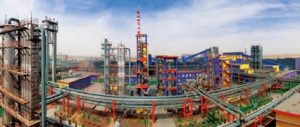Editors’ message
Until recently, carbon capture and storage (CCS) was a phrase largely reserved for detailed discussions in university laboratories or the research divisions of energy giants. That is not the case today. The technology, which captures carbon dioxide produced by fossil-fuel combustion and stores it in deep geological formations, such as oil fields, now occupies a prominent position in climate-change policymaking and the public debate around cutting carbon.
Held up by its advocates as a way of reducing carbon emissions while maintaining a secure energy supply, CCS has gained significant traction with the world’s governments. The United States, United Kingdom, Canada and Australia are among the countries to have pledged large sums of public money to high-profile demonstration projects in the last two years. CCS is considered to be particularly important development for China, where around 70% of energy needs are still met by coal. A commercial-scale "clean coal" project is already under way in the city of Tianjin, in north China, but researchers, such as Stanford University’s He Gang, argue more is needed to promote widespread adoption.
The technology’s enormous expense – the cost of one CCS plant is currently estimated at around US$1.5 billion (10.7 billion yuan) – still stands in the way of rapid deployment. And it has been criticised by some for being a “plaster” for global ills rather than an attempt to deal with the root cause. But more and more policymakers, non-governmental organisations and academics are backing it as one of the many solutions required to cut carbon dioxide output, saying it is an advanced technology with a ready skills base – injecting carbon dioxide underground is an established practice in the oil and gas industry.
CCS is attracting huge global attention. And this week, chinadialogue will look at some of the key issues surrounding its development. Logan West kicks off the series with an explanation of the process’s storage aspects, while Li Jia and Liang Xi analyse the financial stumbling blocks and possible solutions. Later in the week, the Natural Resources Defense Council presents a detailed account of CCS development in China and the global cooperation needed to promote it. As always, we are keen to hear your views, so do please leave a comment – and get involved in the conversation.
Carbon capture and storage (CCS) is a classic relocation-style response, like landfill or water diversion, that is steadily picking up steam. In fact, the International Energy Agency forecasts that CCS will contribute over 10 gigatonnes of carbon-dioxide emissions reductions in 2050, compared to 11 gigatonnes for renewables.
Why the optimism? The concept is simple, the technology exists, industry is proven to have the capacity and CCS is an adaptation, rather than overthrow, of the existing system. That said, CCS lacks neither flaws – energy inefficiency, high costs – nor detractors. While the topic heats up, details of the process itself often get lost in the debate. But an understanding of carbon-dioxide storage is essential to continuing the discussion.
For the non-geologist majority, storage can be difficult to conceptualise. Where does the carbon dioxide actually go? How does it stay there? What happens if it escapes? The storage process presents the riskiest and most uncertain part of any CCS project. Not only can carbon-dioxide release be hazardous, but its escape also undermines the whole process and wastes a lot of time and money doing so.
So how does storage work? It is important to understand that the carbon dioxide being stored is not like the carbon dioxide people exhale every day. The hot, high-pressure conditions of the kilometre-deep storage zones force carbon dioxide into a supercritical state with a liquid-like density, leading it to “flow”, which restricts its buoyancy.
This carbon dioxide is pumped into what geologists call a reservoir. Beneath our feet are layers of rocks, typically stacked one on top of the other. Reservoirs are layers in which fluids like water – called aquifers – and oil or gases accumulate. The key characteristic of reservoirs is that the rocks contain a lot of interconnected, open pore space, which fluids can move through and fill. The injected carbon dioxide “plume” does exactly this.
There are four main mechanisms for keeping the carbon dioxide plume where it is. The single most important factor is the cap-rock, an impermeable layer above the reservoir that holds in the plume the same way that a bottle cap shuts in the carbonation in a bottle of soda. It is essential that cap-rocks, among other traits, are spread over the whole area of the plume – up to 100 square kilometres – and are free of escape pathways such as leaky faults. The cap-rock and other unique geological structures are the frontline for containing carbon dioxide.
As the plume permeates through the pore spaces, the carbon dioxide becomes trapped as some channels are too tight for it to squeeze through. Then, as the gas interacts with the water in the reservoir, some of it dissolves. Once dissolved, the carbon dioxide loses all buoyancy and cannot move on its own. Eventually, a share of the dissolved substance reacts with the rocks to form minerals, solidifying the carbon dioxide in the subsurface, where it will stay for millions of years.
There is plenty of evidence indicating that these trapping mechanisms have been, are and ought to be successful. Naturally occurring carbon dioxide accumulations have been trapped in the subsurface worldwide for millions of years. Meanwhile, ongoing international demonstration projects are successfully conducting CCS. This has led the Intergovernmental Panel on Climate Change (IPCC) to state that, when done right, 99% of the carbon dioxide stored is likely to be retained 1,000 years after injection – time enough to find emission-free energy.
Still, there are a great number of unknowns. In geology, no two locations will ever be exactly the same. Thus, unlike capture technology, there is no “one size fits all” blueprint for carbon dioxide storage. And, while tools help us image the subsurface, they can only provide a sketch of the reality. Regardless of how thoroughly a site is examined, predicting the movement and reaction of carbon dioxide in the subsurface still involves a lot of guesswork. Experience and data do, however, lower the uncertainty and that is why oil fields make likely first-generation storage targets. Their geology is well understood and the carbon dioxide can sometimes be used to push out previously unrecoverable reserves.
The uncertainty can be managed if regulators and project operators work together to ensure that storage is carried out with the highest precautions and attention to efficacy. The key to successful storage is picking the safest site, analysing potential locations to identify one that will not only trap the carbon dioxide but also has the space to hold it all and allows the gas to be pumped in as fast as it arrives from the source.
To back up such research, collected data should be used to develop models of the reservoir that can simulate what the carbon dioxide is likely to do. Monitoring tools should then be put in place to track what it actually does and to test for leakage. Models and monitoring will function in tandem, with an ongoing assessment of the possible risks and plans for fixing leakage should it occur. Regulators should carefully review all preparation work and data before awarding permits for storage sites. They should also consult with local communities. This makes data transparency essential.
Even with all the precautions, carbon dioxide can still leak and the side effects can be serious. While normally non-toxic, heavy concentrations of carbon dioxide in the air can be deadly to humans and plant life. Such serious side effects are only caused by the rapid release of large volumes of carbon dioxide, which is unlikely to happen. However, more plausible, slow seepage of the gas from storage reservoirs can still be hazardous. Carbon dioxide that escapes into shallow aquifers nearer to the surface will react with the water to form a weak acid that can render groundwater non-potable or unusable for agriculture and industry. This acid could even leach toxic metals from the rocks or soils, which would worsen the health and environmental effects. Even carbon dioxide escaping harmlessly back into the atmosphere still contributes to greenhouse-gas emissions.
This raises the following question: is storage feasible? Technically, yes. Economically, yes; storage costs vary depending on the site but typically account for only 5% of the total project. But what about those estimates suggesting China can hold as much as 2,300 gigatonnes of carbon dioxide – or 100 years’ worth of emissions at the country’s current rate? Don’t let these estimates instill false optimism. They are theoretical figures. So much is still unknown that the true capacity is hard to predict. Geological data in China is still limited and little is actually known about the saline aquifers that show the greatest potential.
Where there is data, it is proprietary knowledge of oil companies, which are reluctant to share it freely. Similarly, some spots good for carbon dioxide storage may lead to conflicts of interest if they possess other important resources. Furthermore, China’s reservoirs tend to be very complex, with abundant faulting that potentially compromises safe containment. Even at top-priority oil reservoirs, issues exist due to the number of old exploration wells that need to be located and plugged to prevent carbon dioxide from escaping.
Finally, just because a site makes geological sense, does not necessarily mean it is practically viable. It does not make economic sense to pump carbon dioxide from Shanghai in the east of China to Xinjiang province in the west, just because there is a good reservoir there. Nor does it yet make sense to pump carbon dioxide directly under Beijing or other heavily populated regions. The uncertainties are still too high to justify taking the risk that the gas might leak and, at the very least, damage water resources.
Still, China may well possess many gigatonnes of realistic storage space – enough to play a significant role – and this is where discussion can move back to the big picture of costs, policy and beyond.
Logan West is a researcher at the Tsinghua-BP Clean Energy Research and Education Centre in Beijing.
Homepage image by Øyvind Hagen for Norway’s Statoil shows the Sleipner CCS facility in the North Sea.



